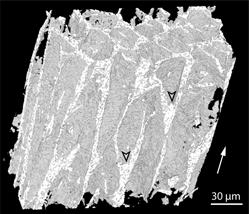Crossref Citations
This article has been cited by the following publications. This list is generated based on data provided by
Crossref.
Wang, Junjie
Gong, Qianming
Zhuang, Daming
and
Liang, Ji
2015.
Chemical vapor infiltration tailored hierarchical porous CNTs/C composite spheres fabricated by freeze casting and their adsorption properties.
RSC Advances,
Vol. 5,
Issue. 22,
p.
16870.
Le Ferrand, Hortense
Bouville, Florian
Niebel, Tobias P.
and
Studart, André R.
2015.
Magnetically assisted slip casting of bioinspired heterogeneous composites.
Nature Materials,
Vol. 14,
Issue. 11,
p.
1172.
Ojuva, Arto
Järveläinen, Matti
Bauer, Marcus
Keskinen, Lassi
Valkonen, Masi
Akhtar, Farid
Levänen, Erkki
and
Bergström, Lennart
2015.
Mechanical performance and CO2 uptake of ion-exchanged zeolite A structured by freeze-casting.
Journal of the European Ceramic Society,
Vol. 35,
Issue. 9,
p.
2607.
Pan, Zheng-Ze
Nishihara, Hirotomo
Iwamura, Shinichiroh
Sekiguchi, Takafumi
Sato, Akihiro
Isogai, Akira
Kang, Feiyu
Kyotani, Takashi
and
Yang, Quan-Hong
2016.
Cellulose Nanofiber as a Distinct Structure-Directing Agent for Xylem-like Microhoneycomb Monoliths by Unidirectional Freeze-Drying.
ACS Nano,
Vol. 10,
Issue. 12,
p.
10689.
Deville, Sylvain
2017.
Freezing Colloids: Observations, Principles, Control, and Use.
p.
351.
Deville, Sylvain
2017.
Freezing Colloids: Observations, Principles, Control, and Use.
p.
253.
Deville, Sylvain
2017.
Freezing Colloids: Observations, Principles, Control, and Use.
p.
91.
Muth, Joseph T.
Dixon, Patrick G.
Woish, Logan
Gibson, Lorna J.
and
Lewis, Jennifer A.
2017.
Architected cellular ceramics with tailored stiffness via direct foam writing.
Proceedings of the National Academy of Sciences,
Vol. 114,
Issue. 8,
p.
1832.
Deville, Sylvain
2017.
Freezing Colloids: Observations, Principles, Control, and Use.
p.
549.
Scotti, Kristen L.
and
Dunand, David C.
2018.
Freeze casting – A review of processing, microstructure and properties via the open data repository, FreezeCasting.net.
Progress in Materials Science,
Vol. 94,
Issue. ,
p.
243.
Christiansen, Cathrine D.
Nielsen, Kaspar K.
Bordia, Rajendra K.
and
Bjørk, Rasmus
2019.
The effect of gelation on statically and dynamically freeze‐cast structures.
Journal of the American Ceramic Society,
Vol. 102,
Issue. 10,
p.
5796.
Akurati, Sashanka
Marin, Justine
Gundrati, Bharath
and
Ghosh, Dipankar
2020.
Assessing the role of loading direction on the uniaxial compressive response of multilayered ice-templated alumina-epoxy composites.
Materialia,
Vol. 14,
Issue. ,
p.
100895.
Banda, Mahesh
Akurati, Sashanka
and
Ghosh, Dipankar
2020.
Governing role of the ratio of large platelet particles to ultrafine particles on dynamic and quasistatic compressive response and damage evolution in ice-templated alumina ceramics.
Journal of Materials Research,
Vol. 35,
Issue. 21,
p.
2870.
Muto, Daimu
Hashimoto, Shinobu
Kondo, Hiroki
Daiko, Yusuke
Honda, Sawao
and
Iwamoto, Yuji
2020.
Fabrication of highly isotropic porous alumina refractory clinkers consisting of platelets using a gelatin-sol.
Journal of Asian Ceramic Societies,
Vol. 8,
Issue. 2,
p.
265.
Mukbaniani, Omar
Brostow, Witold
Aneli, Jimsher
Markarashvili, Eliza
Tatrishvili, Tamara
Buzaladze, George
and
Parulava, Gorge
2020.
Sawdust based composites.
Polymers for Advanced Technologies,
Vol. 31,
Issue. 11,
p.
2504.
Samie, Muhammad
Yameen, Muhammad Arfat
Ikram, Hafiza Fakhera
Iqbal, Haffsah
Chaudhry, Aqif Anwar
ur Rehman, Ihtesham
and
Khan, Ather Farooq
2020.
Fabrication of dual drug loaded bilayered chitosan based composite scaffolds as osteochondral substitutes and evaluation of in vitro cell response using the MC3T3 pre-osteoblast cell line.
Cellulose,
Vol. 27,
Issue. 4,
p.
2253.
Mondal, Ranajit
and
Kumaraswamy, Guruswamy
2022.
Materials prepared by Freezing-Induced Self-Assembly of Dispersed Solutes: A Review.
Materials Advances,
Vol. 3,
Issue. 7,
p.
3041.
Deville, Sylvain
Tomsia, Antoni P.
and
Meille, Sylvain
2022.
Complex Composites Built through Freezing.
Accounts of Chemical Research,
Vol. 55,
Issue. 11,
p.
1492.
Sandberg, Dick
Gorbacheva, Galina
Lichtenegger, Helga
Niemz, Peter
and
Teischinger, Alfred
2023.
Springer Handbook of Wood Science and Technology.
p.
1835.
Le Barbenchon, Louise
and
Viot, Philippe
2024.
From bio-sourced to bio-inspired cellular materials: A review on their mechanical behavior under dynamic loadings.
Materials Letters,
Vol. 355,
Issue. ,
p.
135487.



